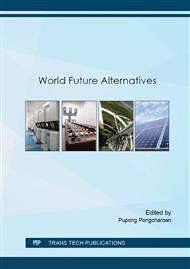p.94
p.100
p.107
p.114
p.119
p.124
p.130
p.136
p.142
Land Use Assessment of Economic Crops for Photovoltaic Power Plant in Phetchabun Province
Abstract:
This research is aiming at the changing land use from agricultural land to photovoltaic power plant. Geographic information system (GIS) technology was used to indicate the unsuitable areas for five economic crops that are paddy, sugar cane, maize, cassava and para rubber. The assess cost, income, and CO2 emission of the economic crops and photovoltaic power plant are the major factors for the unsuitable agricultural land deciding that will be changed to build photovoltaic power plant. The results found that the unsuitable areas for the 5 economic crops are 241,142 rai and the average solar irradiance is 17.6 MJ/m2.day for this areas which is suitable to build the photovoltaic power plant. The profit/losing of paddy, sugar cane, maize, cassava and para rubber in the suitable areas are-1,193 baht/ton, 33 baht/ton, 85 baht/ton, 259 baht/ton and-9,150 baht/ton, respectively while photovoltaic power plant cost and income are 4.12 baht/kWh and 5.65 baht/kWh respectively. CO2 emission of paddy, sugar cane, maize, cassava, para rubber and photovoltaic power plant are 2,315 kgCO2eq/tonpaddy, 37.15 kgCO2eq/ton, 256.12 kgCO2eq/ton, 29.07 kgCO2eq/ton, 153 kgCO2eq/ton and-0.5743 kgCO2eq/kWh, respectively. From these results, land use changing from economic crops planting in unsuitable areas to build photovoltaic power plant is appropriate and worth in the environmental and the economic aspect.
Info:
Periodical:
Pages:
119-123
Citation:
Online since:
June 2016
Authors:
Keywords:
Price:
Сopyright:
© 2016 Trans Tech Publications Ltd. All Rights Reserved
Share:
Citation:


